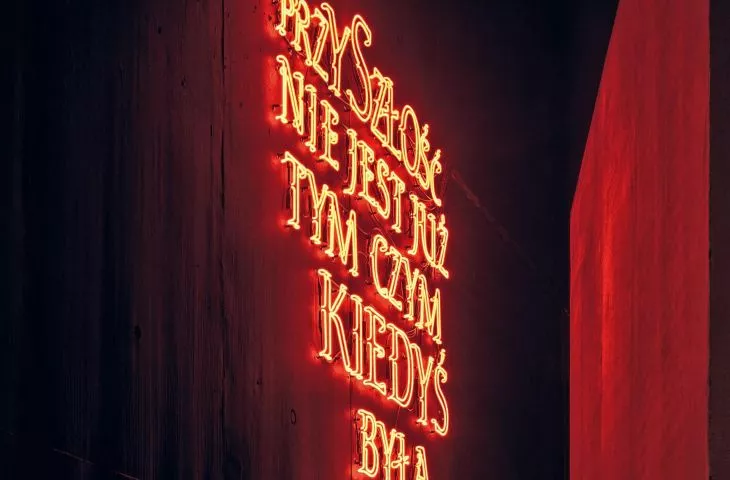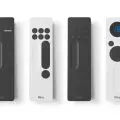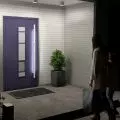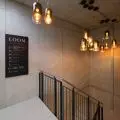From the archives of A&B - the best Polish projects of the last decade
[A&B 04'2016 original material]
Another important protagonist of architectural Szczecin has sprung up at the foot of the Philharmonic Hall - the Breakthroughs Dialogue Center (CDP), a branch of the National Museum in Szczecin, which focuses on showcasing Szczecin's history since 1945. Robert Konieczny's KWK Promes studio from Katowice is responsible for its design and construction. The author does not need to be introduced to anyone, after all, it is well known that he is one of the most consistent, disciplined and charismatic figures on the domestic architectural scene.
Something like this happened in Szczecin, that from a city of provincial character and national importance, in less than a few years it became a kind of symbol of new quality in Polish architecture. The Mieczyslaw Karlowicz Philharmonic building by Estudio Barozzi Veiga, which was awarded the architectural Nobel Prize, the Mies van der Rohe Prize, in 2015, contributed greatly to this phenomenon. This was certainly a turning point, because although the architectural community had previously noticed and appreciated this realization, its acknowledgement through the bestowal of such a prestigious award raised the status of both the city and the building.
The phenomenon called KWK Promes may irritate some, while in others it arouses admiration, but you certainly can't pass by it indifferently, shrugging your shoulders. But that's the way it is with good architecture - it always works on the emotions. Of course, the objective factors that subject it to evaluation are important, such as function, form, design, material, technical and spatial solutions or context. But emotions and sensory perceptions such as smell, touch (yes, touching architecture, getting familiar with its texture, color is an extremely sensual experience and should be recommended to anyone who wants to feel a building, not just read its architectural language), the way the space works, the closer and further plans that surround the user, the furniture and small architecture and the way they are used determine the reception and quality of perception. And this one is important, in the full - intellectual and sensory - perception of reality.
archive photos of Solidarity Square in Szczecin
© KWK Promes
map of meanings
But let's return perhaps for a moment to Szczecin itself. Beautifully located, immersed in greenery, with beautiful parks with old well-kept trees, plane trees along the roads, the boulevards, beautiful old villas in Pogodno, surrounded on all sides by plenty of water makes the moments spent there unique. In addition, the quality urban planning of the "old" Szczecin, the one before urban sprawl, causes the city to have its own unique character, climate and urban atmosphere. The harbor, the shipyard with its cranes, and the islands on the Oder River complete the city's romantic frame. And although recently there have been quite a few good public buildings built with EU subsidies, for example in Warsaw, Katowice, Poznań or the Tri-City, it is hard to resist the impression that it is Szczecin that has won the biggest prize. And by no means because the city's mayor Piotr Krzystek received the Mies van der Rohe Award in Barcelona. Warsaw, Katowice, Poznań and Gdynia all have their own contemporary architectural identity, while Szczecin lacked some. While it has some great projects, including those by Zbigniew Abrahamowicz with the Summer Theater at the helm, no one seems to have taken a wider interest in them, except local enthusiasts. So if provinciality is defined by distance from the capital, including in this metaphorical sense, then Szczecin was certainly neither anywhere near nor on the way. Neither was Olsztyn, Bialystok or Przemyśl. Due to its location, it is also not well connected to the capital. However, it is a significant center and an important reference point for its region, and although it is not located directly on the sea, it is often considered a coastal city. (There's something about that Szczecin air that makes you sense its proximity to the sea!).
Pre-war residential development + post-war square = urban hybrid of square and building
© KWK Promes
What has happened in Szczecin, however, is that a certain spatial-social dialogue has been triggered. Let's note that not so long ago a large part of the city's residents underestimated the city's newest architectural layer, with the Philharmonic Hall and Breakthroughs at the forefront. The Philharmonic in particular aroused surprise: that it was out of context, that it was culturally alien, that it was "such an iceberg in the heart of the city," that it was white, so it would get dirty and age badly, that this, that and the other. The breakthroughs located under Solidarity Square, on the other hand, caused tensions in patriotic and historical circles, among others, because they violated the symbolic space of the city. There were also accusations that the roof, which is a city square, is a "concrete" desert without greenery and urban furniture.
The concept of uplifting the square while preserving traffic routes
© KWK Promes
After the buildings were put into use, however, it turned out that they had grown into the city landscape in a natural and obvious way. From buildings that were questionable, they became places attracted by the quality of the architectural space. Something that fills city residents with pride. Once again the rule is confirmed that good architecture defends itself. There were queues to the Breakthroughs in the first month of the institution's operation, which proves the great interest of Szczecinians in the new facility. The roof attracts residents who have an idea of how to use it - skaters, children, students like to spend time there. (I've also heard that teenagers like to date "at the Gorges"). Thus, Szczecin in a short interval received two interesting and intriguing buildings located next to each other, which refreshed its image and attracted the interest of not only city residents.
mockup
© KWK Promes
The urban context of the Breakthroughs and the Philharmonic is also interesting. The two buildings, completely different in style and at the same time very radical in form, existing side by side, created a kind of spatial dialogue based on the principle of good neighborliness. The Philharmonic came first, so formally Konieczny "had to" get along. And he did it, it must be admitted, with great culture and sensitivity, agreeing to such a clear and dominant presence of the Philharmonic, not arguing with it, not formally shouting at it, not trying to prove that he also knows how to do it. Because he can, after all, he has proven it more than once. He is even a master of designing buildings that become the stars of the foreground. Here the most important thing turned out to be the dialogue and meeting: of two solids and urban-urban context. Szczecin has benefited greatly from this, and therein lies his great victory.
stories
The Breakthroughs Dialogue Center is a long-awaited building. From the birth of the idea in 2005 to the materialization of the idea took 10 years. In 2009, a competition was announced to develop an architectural concept for an exhibition pavilion, a branch of the local National Museum, which was to house an exhibition on the history of Szczecin from 1939 to 1989. KWK Promes studio won the competition with its design for an integrated space of the city square with the building, in which the exhibition spaces and most of the volume were hidden underground.
The building has three entrances: from the side of the Philharmonic Hall (Malopolska Street), St. Peter and Paul Church (Tadeusza Mazowieckiego Street) and from the square, which is a meeting place for Szczecin residents
© KWK Promes
Solidarity Square, which is now a museum roof, has a difficult history. As a result of wartime bombing in 1944, the tenements that made up the city's frontage disappeared. The void left by the buildings was transformed into a square, which in the 1960s became a children's play space loved by local residents with an urban greenery. In December '70, the square witnessed clashes between police and striking workers, sixteen of whom were killed and about a hundred injured. In 2005, to commemorate these events, a monument to the Victims of December '70 was erected there - the Angel of Freedom, which holds a crown of thorns with the inscription "December 1970," and at its base are plaques with the names of the workers who were shot. The Angel of Freedom returned there, by the way, after the construction work was completed and, what can I say, formally it is a completely foreign entity there. The building itself, which is a museum of Szczecin's recent history, can be treated as a memorial, including to the victims of December '70, or an independent monument commemorating this important date in the city's history can be erected, but closer to the aesthetics of the Przemyœlów Monument or the nearby Philharmonic Hall. This can still be done, by the way, while respecting the emotions and feelings of loved ones and families and the memory of the fallen.
In early 2013, a competition was also announced for the development of a visual concept for the exhibition setting the stage for the development of a detailed visual and spatial design. It was won by the Redan studio from Szczecin.
Concrete louvers make the building open to the surroundings or close into a monolithic block
Photo: Jakub Certowicz © KWK Promes
story
The opening of the Breakthroughs was postponed several times, finally the ceremonial event took place on January 25, 2016. The CDP, as the architect himself often emphasizes, is a hybrid of a city square and a building. Ne elevation and the ground floor, where the café, checkroom, cash registers and restrooms are located, use concrete-cellulose panels. The fifth elevation, a usable curved roof - the largest skatepark in Europe, as the local media called it - is a formal continuation of the others. The roof is a wave of concrete slabs with raised platforms appearing in several places that can serve as benches or platforms for parkour stunts.
The building can be accessed directly from the square or from street level: from the side of the church or the Philharmonic Hall. Dipping into the building from the side of the square, a glass lobby opens before the visitor. The entrance areas are highlighted by movable concrete razor blades, behind which are glazed interior facades. The razor blades reveal the museum's interior during business hours and allow natural light inside. In the cooler seasons, as the day grows shorter, the building is a kind of light source. The closed razor blades create a hermetic and introverted mass. The facades then become smooth walls supporting the square and emphasize the minimalist character of the whole.
The open louvers of the building's skin reveal an internal, glazed structure
Photo: Juliusz Sokołowski © KWK Promes
The first floor is a transitional zone between the street or square and the actual exhibition spaces. A public cafe is to operate there, perhaps, a small cozy store or bookstore. From the first floor, down the stairs we go to the actual part of the museum, the exhibition space. The passage itself already seems symbolic - from the fairly well-lit first floor we enter the black cube. Indeed, the entire gallery is flooded with black. Considering the fact that the Breakthroughs Museum is dedicated to Szczecin's recent history, blackness on a symbolic level can be unsettling. One wonders what the curators and creators of this place want to tell us by this? Do they want to draw attention to the darkness and gloom of that history, or to induce a state of focus on the artifacts on view and the narrative of the exhibition? The architect argues that it's all about focus, because by being in such a conceived space, the viewer can focus his attention as if through a lens on the viewed part of the exhibition, stay there in silence and surrender to unfettered reflection. And he convinced me, I believe him.
first floor and level -1 projections
© KWK Promes
Definitely on the plus side of this exhibition should be written the way the narrative is built, without unnecessary theatricality and obtrusive scenery often present in such museums. Polish history museums are fond of creating scenographies that supposedly "help" the viewer read history. In Szczecin, the focus was on a viewer to whom it is not necessary to speak in the childish language of plaster objects that are supposed to "faithfully" recreate history. The bet was on a viewer who wants to learn something about the city, history and people, who can handle the interpretation of facts on his own, who is willing and able to look critically at the historical narratives brought out there.
Teresa Murak's work entitled. "Easter", in the depth of an art installation by Grzegorz Handerk and Michal Libera titled. "Block"
Photo: Jakub Certowicz © KWK Promes
An additional advantage is the presence of works by Polish artists in the historical exhibition. Upon entering the gallery, the viewer is stopped by an illuminated photo-collage by Kobas Laksa. Along the way are, among others: Robert Kuśmirowski, Grzegorz Hańderek, Michał Libera, Tomasz Mróz, Teresa Murak, Henryk Stażewski, Xawery Dunikowski, and the whole thing is closed by Hubert Czerepok's neon sign. It must be admitted that the artists' works contribute a lot to the historical exhibition, complementing it with a pugnacity appropriate for art. The exhibition accentuates the four stages marked on the timeline of post-war Szczecin. The breakthroughs from which the museum takes its name are highlighted. Central to the exhibition are those moments that most built the city's historical identity. So, in addition to documents, witness accounts, we have the workers' protest in 1970, August 1980, August 1988. All given simply and clearly.
***
Szczecin plus nine hundred square meters of the city's recent history, plus art, plus good architecture add up to quite a lot of impressions and experiences that are hard not to appreciate. Ba, even to go on a rainy January Monday from, as it were, the other part of Poland, from Krakow, on an overnight train, to be able to personally experience all this. Was it worth it? Very much worth it. Because Szczecin is cool, and now it has two iconic buildings along the Castle Route, from interacting with which you get chills. At least not from the cold!

















































































